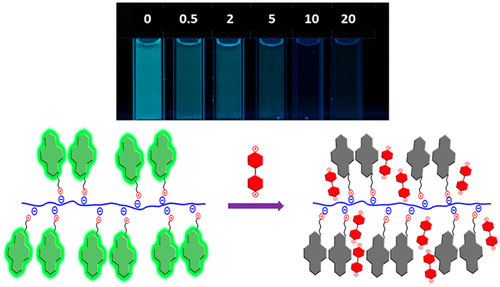当前位置:
X-MOL 学术
›
ACS Sustain. Chem. Eng.
›
论文详情
Our official English website, www.x-mol.net, welcomes your
feedback! (Note: you will need to create a separate account there.)
Rapid and Visual Detection of Bipyridylium Herbicides Based on Polyelectrolyte-Induced Nanoassemblies of Pyrenyl Probes
ACS Sustainable Chemistry & Engineering ( IF 7.1 ) Pub Date : 2020-04-08 , DOI: 10.1021/acssuschemeng.0c01870 Huimin Xu 1 , Keren Xiao 1 , Qiaojuan Zhang 1 , Kunlun Huang 1 , Gang Song 2 , Zhiyi Yao 1, 3
ACS Sustainable Chemistry & Engineering ( IF 7.1 ) Pub Date : 2020-04-08 , DOI: 10.1021/acssuschemeng.0c01870 Huimin Xu 1 , Keren Xiao 1 , Qiaojuan Zhang 1 , Kunlun Huang 1 , Gang Song 2 , Zhiyi Yao 1, 3
Affiliation

|
In this work, we report a novel fluorimetric sensing system for the visual and rapid detection of bipyridylium herbicides (paraquat and diquat) using a polyelectrolyte-induced nanoassembly strategy in 100% aqueous media. This approach relies on the formation of supramolecular assemblies between a pyrenyl probe (N,N,N-trimethyl-4-(pyren-1-yl)butan-1-aminium bromide, PyBTA) and a polyelectrolyte (poly(4-styrenesulfonic acid), PSS), which could promote paraquat complexation by the synergy of noncovalent forces such as electrostatic and π–π stacking interactions. Compared with the traditional direct recognition method, the proposed method shows a 500-fold higher sensitivity, and the detection limit is as low as 40 nM. This assay can be performed within 15 s and can be observed by the naked eye with a visual detection limit of 0.5 μM. Excellent selectivity for paraquat and diquat is demonstrated by a comparison with other pesticides and common ions. This method can be applied to monitor paraquat concentrations in vegetable and soil samples. This approach was validated by paraquat spiking experiments at multiple levels (recovery: 101.2%–104.1%; relative standard deviation (RSD): 2.3%–6.1%; uncertainty: 0.014–0.035). To the best of our knowledge, this is the first pyrenyl nanoassembly system constructed for detecting bipyridylium herbicides in aqueous solution. We believe the present work will not only broaden the scope of polyelectrolyte-induced nanoassembly based sensors but also provide important information for the design of novel synergistic methods for rapid detection technology.
中文翻译:

基于聚电解质诱导的P探针纳米组装体的快速可视化联吡啶鎓除草剂
在这项工作中,我们报告了一种新型的荧光传感系统,用于在100%水性介质中使用聚电解质诱导的纳米组装策略对联吡啶鎓除草剂(百草枯和敌草快)进行可视和快速检测。这种方法依赖于在enyl基探针(N,N,N-三甲基-4-(pyren-1-yl)butan-1-溴化铵(PyBTA)和聚电解质(聚(4-苯乙烯磺酸),PSS),可通过非共价作用力如静电作用促进百草枯的络合和π–π堆叠相互作用。与传统的直接识别方法相比,该方法灵敏度高500倍,检出限低至40 nM。该测定可以在15 s内执行,并且可以用肉眼观察到,其视觉检测极限为0.5μM。与其他农药和常见离子的比较显示了百草枯和敌草快的优异选择性。该方法可用于监测蔬菜和土壤样品中的百草枯浓度。百草枯加标实验在多个层面上均验证了该方法(回收率:101.2%–104.1%;相对标准偏差(RSD):2.3%–6.1%;不确定性:0.014–0.035)。据我们所知,这是第一个用于检测水溶液中联吡啶类除草剂的pyr烯纳米组装系统。我们认为,目前的工作不仅将拓宽基于聚电解质的纳米组件传感器的范围,而且还将为快速检测技术的新型协同方法的设计提供重要信息。
更新日期:2020-04-08
中文翻译:

基于聚电解质诱导的P探针纳米组装体的快速可视化联吡啶鎓除草剂
在这项工作中,我们报告了一种新型的荧光传感系统,用于在100%水性介质中使用聚电解质诱导的纳米组装策略对联吡啶鎓除草剂(百草枯和敌草快)进行可视和快速检测。这种方法依赖于在enyl基探针(N,N,N-三甲基-4-(pyren-1-yl)butan-1-溴化铵(PyBTA)和聚电解质(聚(4-苯乙烯磺酸),PSS),可通过非共价作用力如静电作用促进百草枯的络合和π–π堆叠相互作用。与传统的直接识别方法相比,该方法灵敏度高500倍,检出限低至40 nM。该测定可以在15 s内执行,并且可以用肉眼观察到,其视觉检测极限为0.5μM。与其他农药和常见离子的比较显示了百草枯和敌草快的优异选择性。该方法可用于监测蔬菜和土壤样品中的百草枯浓度。百草枯加标实验在多个层面上均验证了该方法(回收率:101.2%–104.1%;相对标准偏差(RSD):2.3%–6.1%;不确定性:0.014–0.035)。据我们所知,这是第一个用于检测水溶液中联吡啶类除草剂的pyr烯纳米组装系统。我们认为,目前的工作不仅将拓宽基于聚电解质的纳米组件传感器的范围,而且还将为快速检测技术的新型协同方法的设计提供重要信息。











































 京公网安备 11010802027423号
京公网安备 11010802027423号